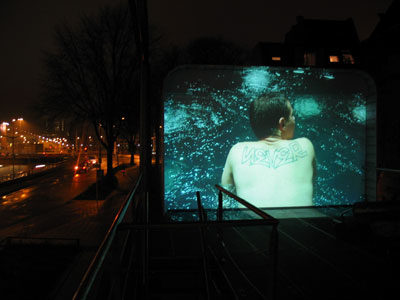Fourteen days, fourteen moods. A tale of a journeying artist, blithely and freely manoeuvring through life. From Tokyo to New York, from London to Miami, starting in Antwerp where she mounted and opened an exhibition. A series of images giving an account of her personal life. The exhibition itself, the opening, her stay there and so on and more of the same. Including a visit to Japan where her sister got married in classical Japanese style, a visit to Los Angeles where she recently lived, and to New York in the company of her friend Miltos Manetas. And then to Miami, in company that you wouldn’t necessarily trust at first sight.
Mai Ueda in bed - Mediamatic Buitenprojecties, november 2003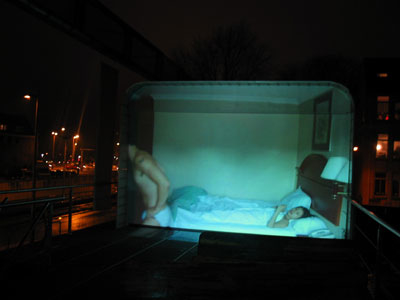
Beautiful girls on the beach, husky boys in expensive cars, even more beautiful girls and husky boys, but Mai herself above all. Not that she is always that girl on the recliner somewhere by a swimming pool or on the beach. And neither are the other pictures all portraits of Mai by any means: yet I have seldom seen a more personal diary. Everything she sees and everything she photographs is coloured by her personal touch.
Her presence forms a natural centre point, possessing a power of attraction organising everything around it. This strategy mainly works when she does not reveal herself, but others. It is fascinating to observe how she personifies herself in the people around her, how she partially strips those she photographs of their personalities and secures her own presence even more obviously in the space that is freed up.
Something similar happens with Andy Warhol, but in the opposite way. When Warhol photographed the temperature became super cool, below body temperature, and Warhol could even become the other, could make himself disappear into his subject. Warhol’s seductiveness and fatal fascination ensured that the subject was painfully thrown back onto him/herself in his best photos, for the photograph no longer existed. Look at the Warhol photos, no one is ever relaxed. Look for example how Warhol leaves Marcel Duchamp to his fate. That is Warhol at his sharpest. The cause of it is very simple: Warhol intimidated the other person, created distance in his self-chosen isolation. His wizardry did not attract, it repelled. A wizardry that becomes even more obvious when compared to Mai’s contrasting magic.
When Mai photographs it is just as if you see life switch to a higher level of energy. Mai reveals a warm outlook, other than Warhol’s abstract, ice-cold eye. She radiates, and the other person radiates too. That is of course Mai’s natural habit: whatever mood she is in, she drags her surroundings along with her. Whatever she photographs, in her photos all her moods are put into images precisely and astonishingly clearly, reflected in the subjects she portrays.
Here we have a diary of fourteen days, in which you can gauge her moods as it were from minute to minute in the light of various photos. With the images of her sister’s wedding in classic Japanese style as a dazzling climax. The subject, in its blend of modernity and classical values is almost a cliché, famous from so much coverage in so many magazines. But that coverage is from another world, while here it is suddenly personalised detail. It is lovely to see how old and new blend in a relaxed embrace, karaoke and the classical singing, a glittering Rolex on the arm of a wedding guest clad in an elegant dinner jacket lined up next to the bride in a traditional wedding dress.
Projection by Mai Ueda - Mediamatic Buitenprojecties, nov 2003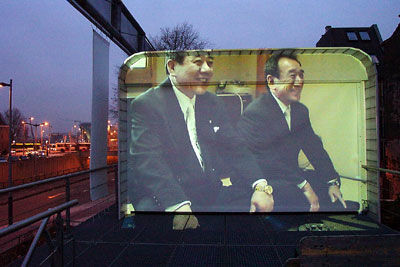
Then again there are the photos from elsewhere in the world which you might be allowed to view as an account of a failed day. Mai’s mood is conveyed by overexposed photos shot to the side of the subject, smoky atmospheric pictures, hazy facial expressions, bad weather, rain and mist. The morning after the party, the party itself, everything is reproduced just as it clearly was, obviously not a successful party. Then the logos of modern life that so frequently appear in her urban images can no longer keep up the illusion. But her bravura, her indisputable longing to be the centre point when things are going well has not passed. On the contrary, even if she would want to hide, it would be impossible. The world adapts to her mood. Each environment is filled with sadness, it is easy to read her mood from her friends. Whereas in cheerful moods those who surround her become stars, her friends and acquaintances are now only melancholic witnesses.
But perhaps the most surprising pictures are those in which Mai herself is to be seen. Pictures that are either quickly shot by somebody else, or – more attractively – those where she photographs herself and parts of her body appear. Or the photos in which she momentarily peers round the corner as she shoots a plate, with an extended hand. This is all very classy, like you used to see in the early Godard films, when he dissected his starlets into fragmentary women in different cuts. Godard used his girlfriends for this. Mai is more modest, and thus more straightforward. In the speedy snapshots her camera sees just as much of the other person as herself. She fragments herself into components.
Projection by Mai Ueda - Mediamatic Buitenprojecties, nov 2003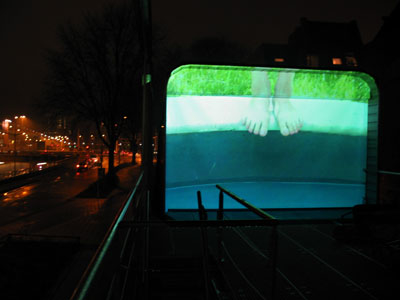
And that works very well. She delivers herself to the gaze of the motorist in those open-air projections of her diary. You could see it happening again and again: the car-driver briefly stuck in rush hour traffic, the commuter driving by, the tourist passing as if by accident, the cyclist on the way to the Nemo for a meeting. Their glance always had an extra gleam when they passed the Mediamatic Supermarket. Their attention was always attracted back to the open-air projection with Mai’s visual diary. There at the crossover to the IJ-tunnel, where actually the sun at your back had already set. Yet it still seemed as if the last rays had been absorbed into that open-air projection as if a fairy had held onto the light.
"I am Mai", Mai Ueda - Mediamatic Buitenprojecties, nov 2003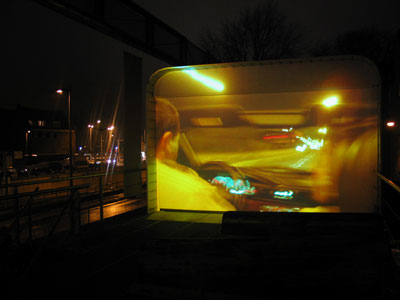
Mai has optimally used that belated sunset idea. Those participants in the passing traffic saw it correctly. You could almost hear them muttering Self portrait of an artist as a young woman. For the last sunbeams (a delayed reflection of the mysterious light mirrored in a different place every time) had taken on Mai’s form! A part of her body, a facial expression, the letters of her name — all the fragments composing Mai are blown all around Amsterdam and its environs.
And the nice thing is that the passers-by who have taken away something of her, do not even understand that they too are playing along in an artistic game. They will carry the diary with them forever. And from all those diverse fragments you could reconstruct a diary once more. Mai’s diary lives on, as long as snatches of it remain in the motorists’ heads. Only when they have been forgotten there will this projection of Mai’s diary cease. But that will probably not happen very quickly.
If you'd like to quote something: Groot, Paul. "I am Mai." Mediamatic Off-Line vol. 11 # 2 (2006).
Projection by Mai Ueda - Mediamatic Buitenprojecties, nov 2003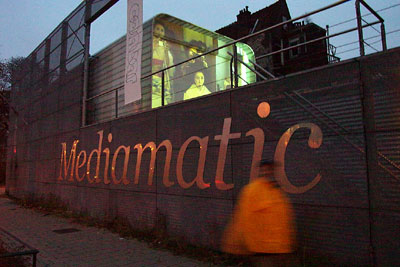
Translation: Helen-Anne Ross
